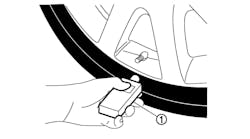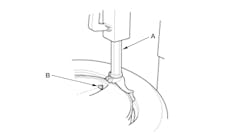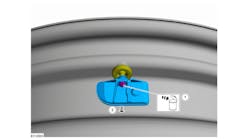Wheel speed sensors and how we test them have been changing. Currently, two types of wheel speed sensors are in use: magnetic inductive (passive) and magneto resistive (active). Passive sensors have been around since the early days of the anti-lock brake system (ABS). These are the sensors that function on the generator principle. The sensors work with the toothed tone wheels to monitor and provide the anti-lock brake module (ABM) with wheel speed information. The actuator is a toothed tone wheel that rotates with the individual wheel. Each tooth on the tone wheel acts as an actuator for the wheel speed sensor. As the tone wheel rotates, the teeth go in and out of the proximity of the sensor. The result is an alternating current (AC) voltage that is generated in the speed sensor coil by magnetic lines of force fluctuating as the tone wheel passes by the magnetic sensor.
The output of the wheel speed sensor can vary from vehicle to vehicle due to: winding type, air gap, magnetic strength of sensor, metal properties of the tone wheel and tone wheel speed. As we have learned over the years, these types of systems have been prone to false cycling, which is the term used to describe an ABS cycle even though the road conditions do not dictate the need for this cycle. This condition is very prone to happen at slower wheel speeds. The customer may describe the symptom as:
* “Something is wrong with my brakes,” or
*“The ABS system is operating as I am coming to a stop sign,” or
* “The brake pedal is dropping while I am braking.”
This happens mostly due to tone wheel damage or rust build-up on the tone wheel. An incorrect sensor air gap will cause this condition, as well as debris on the wheel speed sensor tip. Be sure to check these areas.
Active wheel speed sensors have been in use since 1999 on models using the Teves Mark 20e system. The Teves Mark 25, Teves Mark 25e, TRW EBC-340, some EBC-125 and the late model Bosch systems use this style sensor as well. This style sensor helps increase performance, durability and low speed accuracy. In other words, these sensors do not seem to have the false cycle problem like the passive sensors do. Most vehicles with active sensors still use a toothed tone wheel which acts as the trigger mechanism for the sensor. The LX vehicles (Chrysler 300, Dodge Magnum, and Dodge Charger) use a magnetic encoder in place of a traditional tone wheel. The encoders have north/south pole magnets imbedded into the ring. The ring is then pressed on the axle shaft just like a tone wheel. In either case the result is a digital square wave signal.
On this system, the ABM sends battery voltage to the sensor to power it up. The sensor, in turn, supplies the ABM a constant 7 milliamp (mA) signal on a signal return circuit. Depending on the tone ring or magnetic encoder position, this 7 mA signal is turned on or off. The output of the sensor sent to the ABM is a Direct Current (DC) voltage signal with changing voltage and current levels. The ABM monitors the changing digital signal from each wheel speed sensor and is interpreted as wheel speed.
It is important to note two things: 1) If there is no battery voltage to this sensor, then the sensor will not work at all, and 2) The signal return circuit is where the sensor can be tested. The normal voltage level, as the wheel is rotated, switches between approximately 0.8 volts and 1.6 volts. If using a labscope for testing, this will appear as a square wave signal.
Then along comes Teves Mark 25e. This system uses the active wheel speed sensors, but testing them is different; it is tested on the power supply wire. To make things more complicated, the voltage only changes 0.2 volts as the wheel is rotated! A normal voltage switch on this system is approximately 12 volts to 12.2 volts. To make matters worse, all of the service information available at the time of this article is wrong! Currently, the service information shows testing the sensor on the signal return wire and does not have the correct voltage levels.
Testing this system can also be accomplished using a labscope. Instead of putting the ground lead on ground, put it on battery voltage. Now, using the channel one lead of the scope, watch the signal on the sensor power supply wire. Set the scope to a low voltage range such as 0.5 volts per division. As the wheel is slowly rotated, a square-wave signal can be seen. The voltage level is still only changing 0.2 volts, but with the scope set up like this, the signal is easier to see.
Tip of the day: Make sure you know which ABS system you are working with as they need to be tested differently. The type of ABS system can be identified by checking the “Module Information” on a compatible scan tool. Another way to identify active sensors from the passive style is to use a wire diagram. If the wire diagram lists a sensor as “12 Volt Supply Circuit,” it is an active wheel speed sensor system.
Source: Identifix Inc.




